According to GlassDoor, a user experience (UX) designer is one of the highest-paying entry-level jobs, with pay ranging from $81,000 to $139,000. At a more senior level, the title of Director of UX Design nets a range of $184,000 to $290,000 — so you may be wondering how to get into UX design.

To become a UX designer, you need experience with UX design, graphic design, market research, and psychology, among other skills. While many UX designers start out in web design or development, anyone in a related field can acquire the skills needed to become a UX designer.
In this guide, I’ll walk through how to become a UX designer with no experience, how long it takes, and what qualifications you need to get hired. Feel free to click on any of those links to jump to that specific section or keep reading.
Table of Contents
- How to Become a UX Designer with No Experience
- How long does it take to become a UX designer?
- UX Designer Qualifications
- Top Advice for Getting Into UX Design
How to Become a UX Designer with No Experience
- Take a UX design course.
- Create some designs independently.
- Get some hands-on experience.
- Create a portfolio.
- Network.
- Apply to UX designer jobs.
- Keep learning.
I caught up with a few UX designers and hiring managers to get a sense of how you can break into the field. While getting into UX design doesn’t require specific experience, many people in this space come from related fields.
Pro tip: Zack Naylor, CEO and Co-Founder of Aurelius, shares, “I got into UX after having been a front-end developer and visual designer for a while. In doing that work, I always felt like I knew what “better” design was, and it had little to do with how things looked. It was more about how they worked.”
And since 92% of UX professionals report career satisfaction, it’s a field that has lots of potential for overall happiness—because, in my experience, when you enjoy your job, it makes the rest of your life even better.
Want to start creating your UX design path? This video offers a quick overview of some core steps anyone can take to become a UX designer with no experience or keep reading.
1. Take a UX design course.
There are over 140 UX-related bachelor’s and master’s degrees available at universities around the world. These degrees are in fields related to UX like Interaction Design, Information Architecture, and Digital Design, among others. Most take between two and four years to complete.
Pro tip: Nadia Xu from Designity recommends finding a specialized UX design course.
“I hold an undergraduate degree in business and a master‘s degree in fine art, which naturally led me to UX, a field that bridges business, technology, and design. After recognizing my growing interest in UX design, I also pursued a master’s degree in the subject to systematically learn about the foundational and technical knowledge necessary for the field,” Xu says.
If you’re looking for a faster, more flexible alternative, then you might consider a UX design course. Many offer certifications that can help your resume stand out.
For example, Google offers an online course for a UX Design Professional Certificate. It takes approximately six months to complete and makes it easier to apply for UX designer jobs with over 150 U.S. employers, including Google, Walmart, and Best Buy.
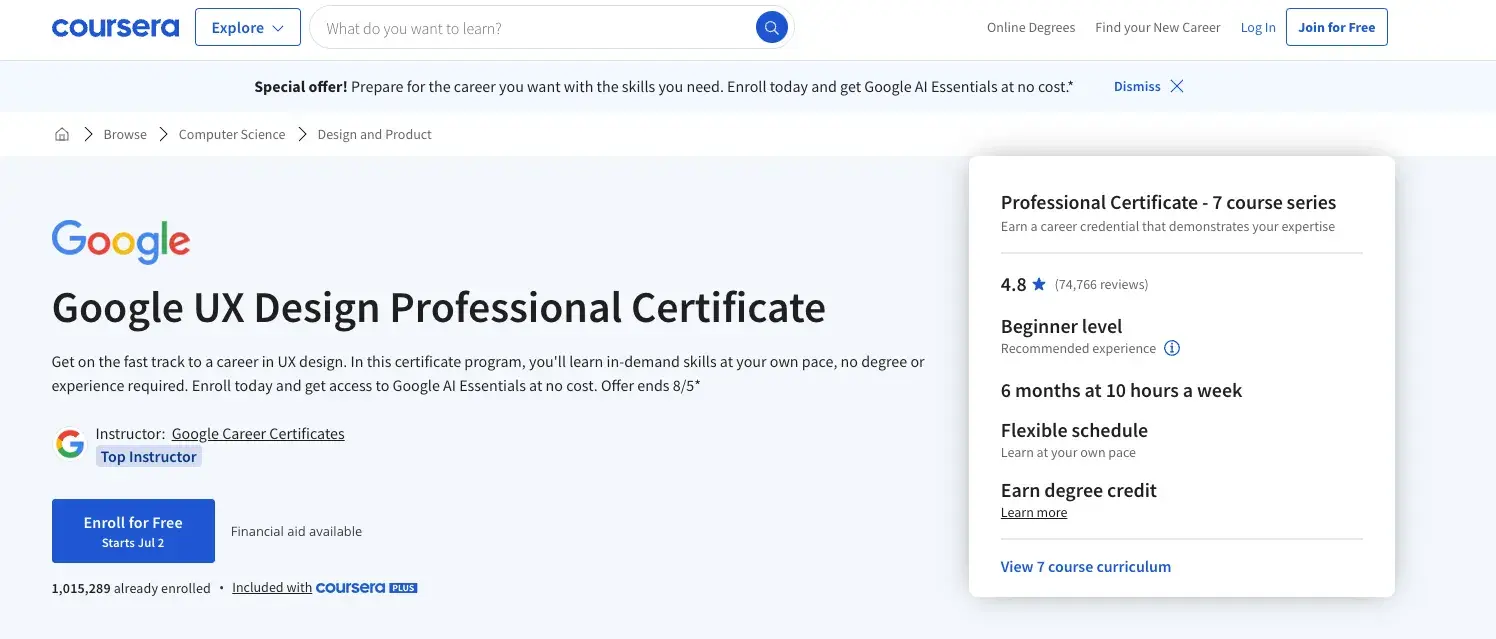
2. Create some designs independently.
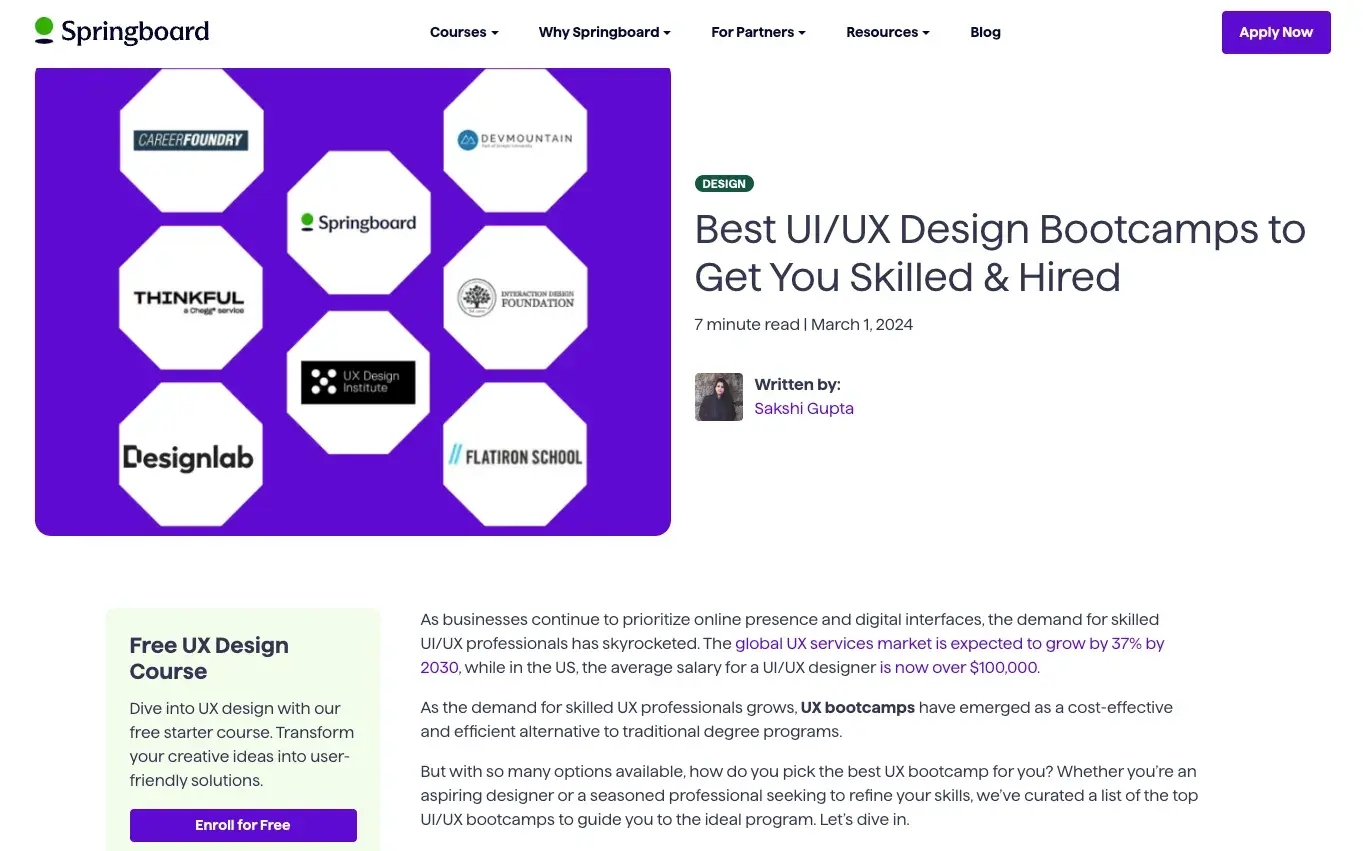
During a UX design course or bootcamp, you’ll typically complete at least one project. You should continue to make designs outside of the course or bootcamp in order to get as much experience with different tools and types of designs as possible.
When you’re happy with the designs, consider sharing them on sites like Behance and Dribble to get some visibility and feedback. This can be a great way to start building your portfolio and your network in the UX design community.
Here are some examples of UX designer Emi Lantz’s work on Behance:

3. Get some hands-on experience.
To really put your skills to the test, consider a design internship or freelance work. This will be an excellent experience to put on your resume and another great way to build out your network.
More importantly, it will help you to build a solid foundation in project management, collaboration, and communication skills. These soft skills are just as important as the technical skills required of a UX designer.
You can find internship or freelance opportunities on sites like LinkedIn and Upwork. Currently on Upwork, there are over 850 UX designer freelance jobs:
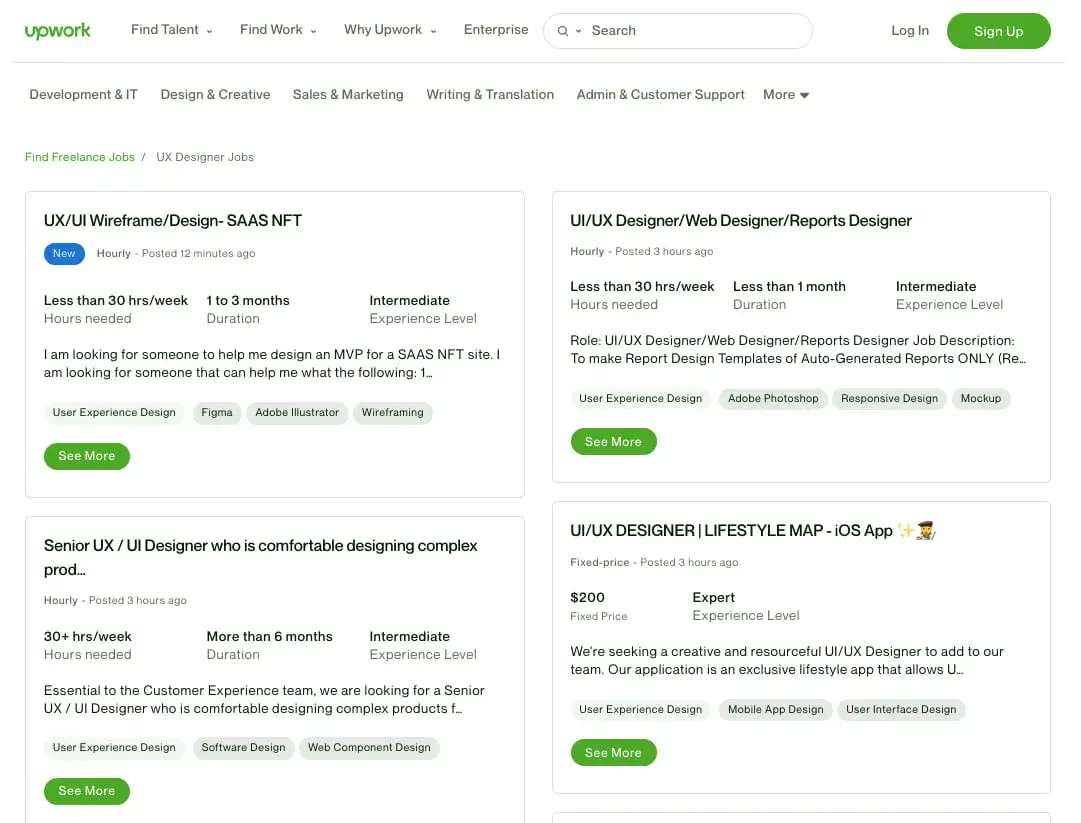
4. Create a portfolio.
Once you’ve completed the steps above, you can create a portfolio of your best work.
In an article for UsabilityGeek, Gassia Maljian, the executive search director at Creative Niche, emphasized how important portfolios are: “They show all the work a designer has completed and they support all of the experience listed on a resume. It’s important to ensure you are including a variety of samples in your portfolio with as much of the process traced out as possible.”
Rose Benedict adds that after taking a web design class, she knew she wanted to get into UX design.
“I began interviewing and only applied for graphic design positions that involved some type of UX component. I also added some self-initiated work to my portfolio to show my potential employer that I really thought through UX design problems and was able to secure my first UX design position that way,” Benedict says.
.png)
Free UX Research Kit + Templates
3 templates for conducting user tests, summarizing your UX research, and presenting your findings.
- User Testing Template
- UX Research Testing Report Template
- UX Research Presentation Template
Download Free
All fields are required.
.png)
Your portfolio should include demo work as well as work you produced for clients or a company during a freelancing gig or internship. This is essential for demonstrating your skills and process for improving the user experience, as well as your impact. Make sure to include the results of the work you completed in addition to testimonials if you have them.
Emi Lantz, for example, features a slider of testimonials on her portfolio website that attest to her talent, work ethic, and impact:
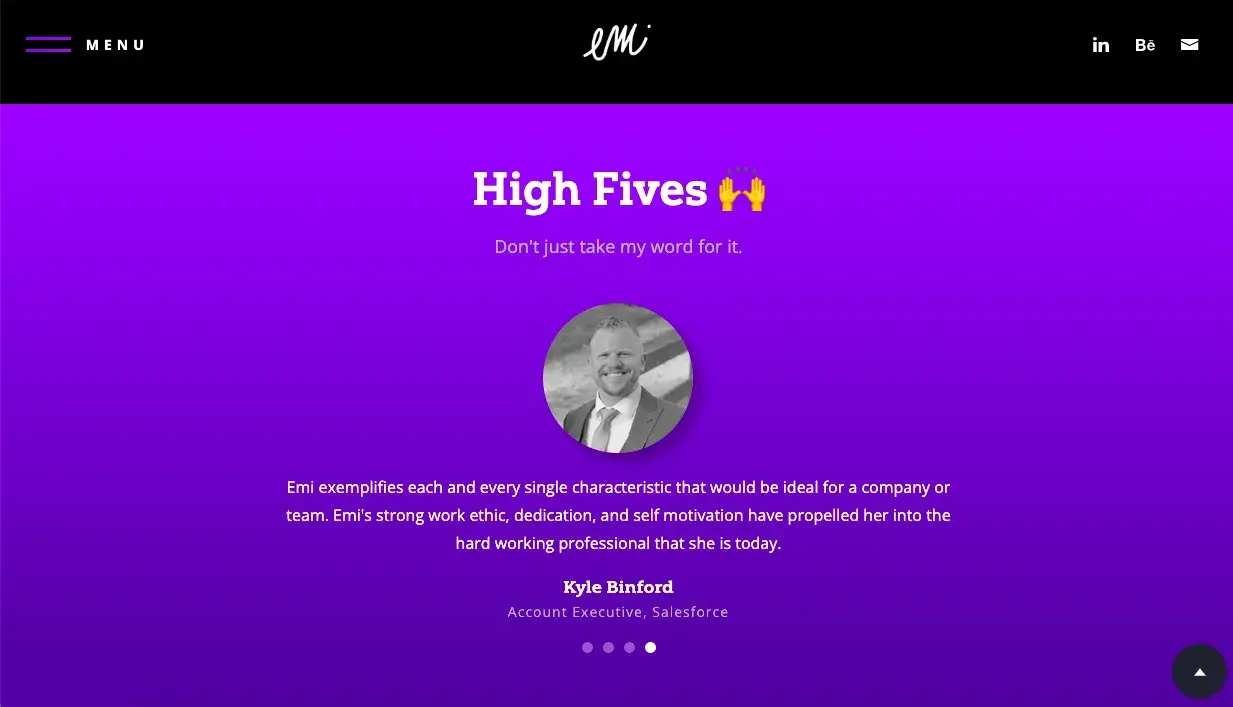
5. Network.
Networking is important for getting into UX design for two major reasons: it can help you find mentors and job opportunities.
When trying to become a UX designer, reaching out to seasoned designers who have more years of experience working in the field can provide valuable insights into how to be successful.
You can learn what tools are best to learn, what trends are emerging, and more. If you develop a meaningful relationship with them, then they may even let you know what job opportunities are available at their companies and refer you.
To find designers with skills and experiences that you’re interested in, try joining a design community like Design Buddies on Discord or User Experience Design on LinkedIn.
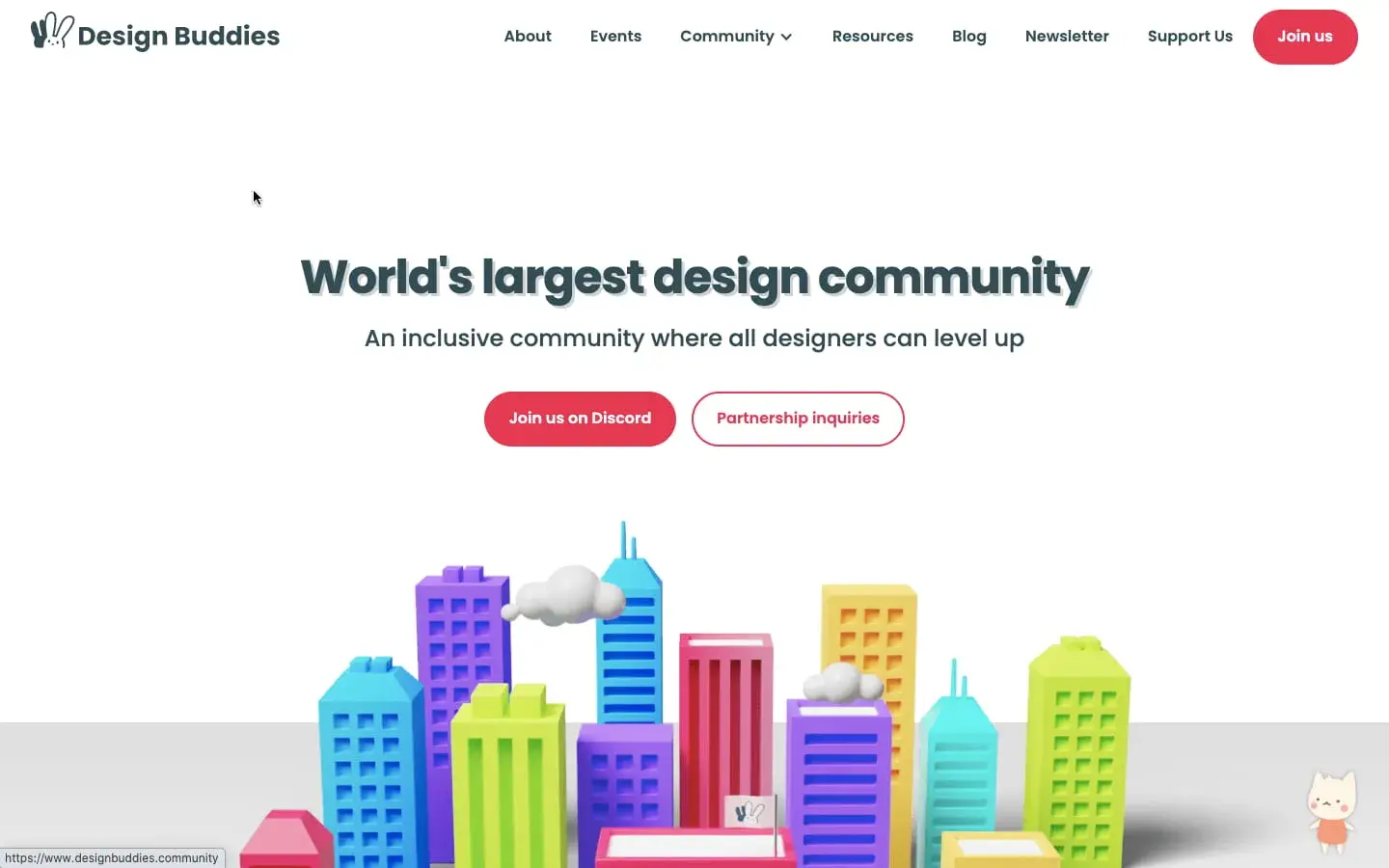
6. Apply for UX designer jobs.
With your education, experience, and portfolio, you’re ready to start applying to jobs.
LinkedIn, Indeed, and Glassdoor all have hundreds or thousands of UX designer job listings. For example, Indeed has almost 14,000 UX designer jobs listed currently.
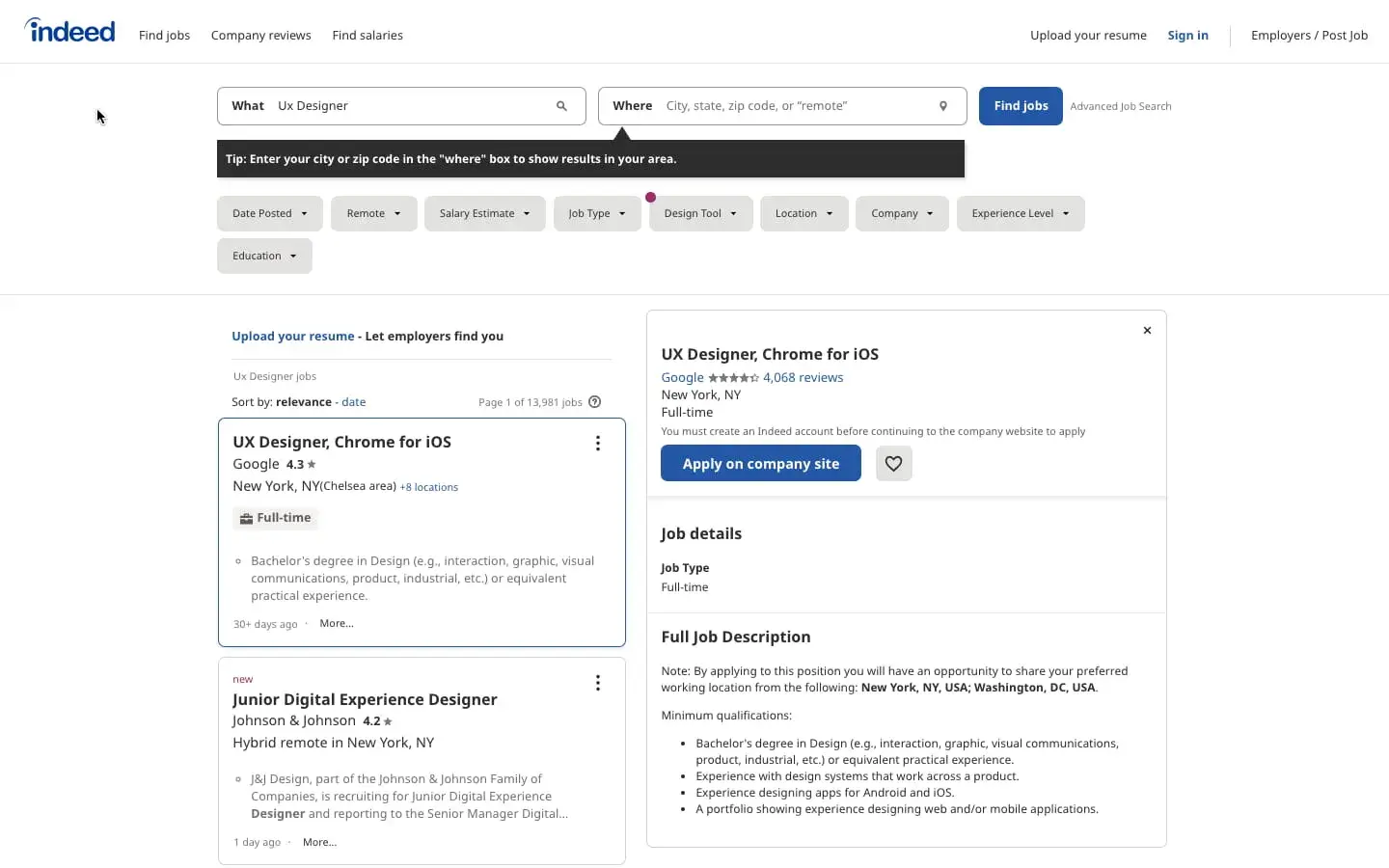
There are a lot of titles in the UX design field that emphasize different skill sets, like coding, content strategy, or usability. In your job search, look out for any of the following titles, but make sure to read the descriptions and qualifications to see if they align with your skills and interests:
- UX designer.
- Experience designer.
- Visual designer.
- UX writer.
- UX architect.
- Information architect.
- UX researcher
- UX engineer
- Interaction designer.
7. Keep learning.
Once you land a job as a UX designer, it’s imperative to keep learning to improve your skills, create new types of design solutions, and stay on top of new trends and tools.
Pro tip: Leizel Laron of ExaWeb says ongoing education is the most important thing for UX designers: “I’ve found that it’s about more than designing — it’s also about problem-solving and critical thinking, which are both needed to keep up with evolving technologies."
You can do this independently by reading and creating designs for your portfolio site, or you can continue to take design courses. Look for courses that specialize in a topic or area of your field that you don’t have much experience in, like journey mapping, for example.
Here are some courses that might benefit UX designers of many experience levels:

Now that we’ve discussed the different steps to becoming a UX designer, let’s consider how long the process will take to enter the field.
How long does it take to become a UX designer?
On average, it takes between two to six years to become a UX designer, but it can take as little as three months.
Since there are no formal UX designer education requirements mandating a certain degree, certification, or license, the timeline can range dramatically.
However, as discussed above, there are steps you can take to improve your chances of landing a job as a UX designer. Here is an estimated range of how long each step in the process of becoming a UX designer can take to complete.
Looking to dip your toes into UX? Get started with our free UX research kit and templates.
Degree in UX-Related Field: 2 to 6 Years
76% of UX professionals came from another career — including lumberjacks and jewelry designers—so regardless of where you’re starting now, there’s almost certainly a path for you. That said, according to 2024 data from the UX Design Institute, 52% of hiring managers want a certificate or diploma in UX, 23% would look for a Bachelor’s degree, and just 2% look for a Master’s.
Depending on whether you decide to pursue an associate’s or Bachelor’s degree in computer science or a related field, then that’ll take between two and four years to get the education you need to get into UX design. A master’s degree will add another two years.
UX-related degrees include:
- Computer science
- Graphic design
- Game design
- Information technology
- Web design
- Marketing
- Psychology
While a Bachelor’s degree is not a requirement for getting into UX design, many job postings list a Bachelor's degree in design, human-computer interaction (HCI), psychology, computer science, or a related field or “equivalent professional experience” as a basic qualification.
This underscores that while there are some undergraduate degrees that can help you prepare for a career in UX design, there’s no single path. Some UX designers will have commensurate experience or a combination of education and experience.
UX Course: 6 Hours to 10 Months
UX courses are another way to learn UX design fundamentals and tools. Often, these are offered online and self-paced, so you can fit them into your schedule more easily than a formal degree. UX courses also range drastically in duration. Some only take a few hours to complete, while others take months.
Here’s a handful of courses with an estimation of how long they take to complete.
- Introduction to User Experience Design by Georgia Tech: 6 hours
- User Experience: The Beginner’s Guide by Interaction Design Foundation: 7 weeks
- Beginner UX Design Course by UX Academy: 2 months
- UX Design Immersive Online by General Assembly: 3 months
- Google UX Design Professional Certificate: 6 months
- UX Design Program by Career Foundry: 10 months
UX Internship or Freelance Job: 1 to 6 Months
UX internships typically last 10 weeks. Many take place in the summer. Freelance jobs range more widely, between 1 to 6 months, depending on the company and project.
Here’s an example of a UX design intern posting:

Looking at these time ranges may be disheartening if you’re looking to switch career paths, but again, there are no formal requirements for becoming a UX designer, so every path is unique.
In the video below, for example, Senior Product Designer Rachel walks through how she became a UX Designer in three months with no degree or experience:
UX Designer Qualifications
UX designer qualifications include experience with UX design, UX software, prototyping, user research and testing, collaboration and communication skills, and a demonstrated understanding of front-end technologies, user-centered design, and mobile-first and responsive design. An online portfolio or samples of your interaction and visual design work is expected.
The qualifications above are commonly found on UX designer job postings, but every job posting will be unique to the company and role’s seniority level and pay range. Here’s an example of a job posting by the freelancing platform Toptal:

Top Advice for Getting Into UX Design
One of the questions I asked each of the UX designers I connected with was, “What is your top advice for new UX designers?” Here’s what each of them had to say:
Xu shares the importance of finding something that appeals to you.
“My primary advice is to understand your strengths. UX is a broad discipline, often conflated with UI or product design by many companies, so reflect on what excites you—is it creating visually appealing designs? Brainstorming product functionalities? Conducting research? Something else?” Xu says.
While Naylor began as a designer, these days, he wears a hiring manager hat and recommends that new designers share their process.
“I want to see how you think, how you understand a problem and the approach you take to solving it. UX is about SO MUCH more than how something simply looks. Great visual design is important, but it's only a piece of the puzzle to a great product and experience,” Naylor says.
Benedict shares that having a portfolio served her well as she was learning how to get into UX design: “My biggest advice to UX designers just starting in this field is to create self-initiated work, especially for the industry (or type of business) that you want to work with. This shows initiative and the ability to solve problems, which is extremely valuable in this field.”
Laron rounds out the discussion, saying, “The best advice I can give to future UI/UX designers is to be flexible and keep your skills up-to-date. With the latest trends in design and technologies, you can enhance your effectiveness in your work and be a reliable part of the team too."
Starting Your Career in UX Design
UX designers must understand how programs work, how people think, and how they’ll interact with the app.
To succeed in UX design, you might use a wide range of qualifications that could include everything from understanding responsive design to user research and testing and much more. It can take time to acquire the right skill set, but there are no formal requirements or single path to becoming a UX designer. That means anyone can have a lucrative career in UX design. So why not you?
So, my advice? Take the advice of these experts to heart, choose a starting point, and dive in!
Editor's note: This post was originally published in April 2022 and has been updated for comprehensiveness.






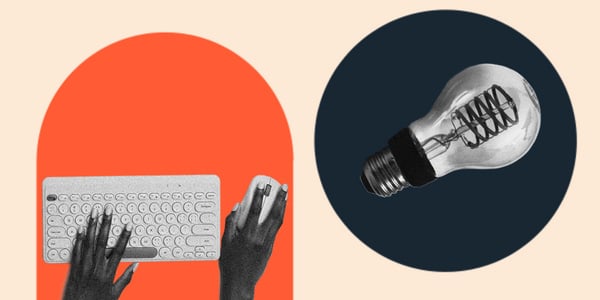
![Website Navigation: The Ultimate Guide [Types & Top Examples]](https://knowledge.hubspot.com/hubfs/ft-nav-bar.webp)
![What Is End-User Experience Monitoring? [+Tips For Implementing It]](https://www.hubspot.com/hubfs/end-user-experience-monitoring.png)

